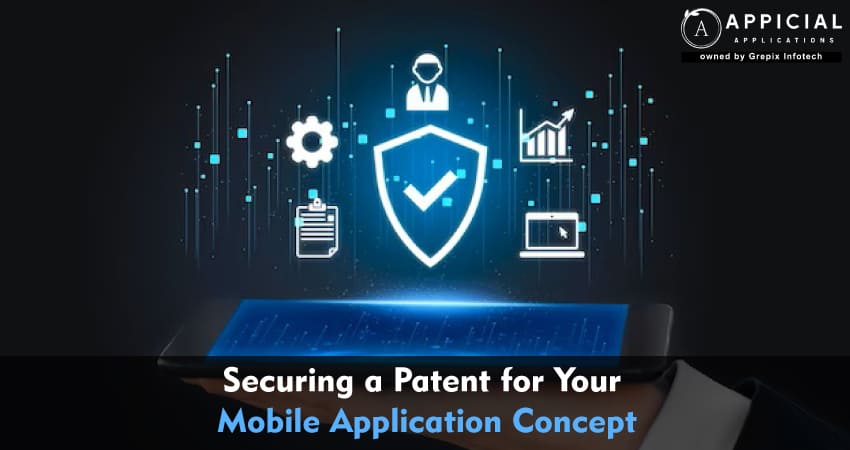
Securing a Patent for Your Mobile Application Concept
Imagine, though, if someone else were to conceive the same app idea, develop it before you, and garner the recognition you believe is rightfully yours! This is where the power of a PATENT, under intellectual property law, becomes your safeguard.
However, before diving into the patent process, it's vital to be aware of some critical data concerning patents.
According to a study by Lexology of the United States Patent and Trademark Office (USPTO), approximately 646,855 patent applications were submitted in the fiscal year 2022, with only 382,559 of those applications resulting in granted patents. Of these, about 56% were awarded to international companies, including giants like SAMSUNG, which received 6,248 patents, and IBM, with 4,398 U.S. patents.
Given these statistics, the urgency of patenting a mobile app idea becomes clear, as it not only provides protection against imitators but also offers numerous advantages. Consequently, one of the predominant inquiries from startups and entrepreneurs contemplating mobile app development is, “How do I patent a mobile app?”
In this guide, we aim to provide a comprehensive overview of the patenting process for mobile apps, equipping you with the knowledge to confidently proceed with your patent application.
This blog provides a comprehensive guide on patenting a mobile app idea, emphasizing the importance of securing intellectual property rights to protect unique functionalities and innovations in the competitive mobile app industry. It outlines the eligibility criteria, types of patent applications, and detailed steps involved in the patenting process, including conducting a patent search, determining the appropriate type of patent, preparing and filing the application, and navigating the examination process. Highlighting the value of patents in enhancing credibility, attracting investors, and opening revenue streams, the blog also offers resources for assistance in patent research and application preparation, ensuring inventors can confidently protect their groundbreaking inventions.
Understanding the Process of Patenting a Concept for a Mobile Application
Patenting a mobile app idea involves securing legal protection for the unique functionalities, processes, or methods your app employs, thereby granting you exclusive rights to use, sell, or license your invention. This intellectual property protection is critical in the fast-paced and competitive world of mobile applications, as it prevents others from copying or capitalizing on your innovative concept without consent.
A patent on a mobile app idea not only serves as a shield against infringement but also as a valuable asset that can enhance your credibility in the market, attract investors, and potentially open revenue streams through licensing deals. However, achieving patent protection requires demonstrating that your app is novel, non-obvious, and has a practical utility, navigating through a meticulous application process that involves thorough documentation and sometimes years of examination by the patent office.
Types of Patent Applications
Navigating the world of patents involves understanding the various types of patent applications available. Each type serves different purposes, fitting various stages of invention development and offering different levels of protection. Here's a breakdown of the primary types of patent applications:
1. Provisional Patent Application
A provisional patent application is a temporary application filed with a patent office. It's not a formal patent application and won't directly lead to a patent on its own. However, it establishes an early filing date and allows the inventor to use the term "patent pending" for their invention. Inventors have 12 months after filing a provisional application to file a corresponding non-provisional application.
2. Non-Provisional (Utility) Patent Application
A non-provisional patent application, often simply referred to as a utility patent application, is a formal document filed with a patent office that begins the examination process for a patent. It requires detailed descriptions of the invention, claims that define the scope of the invention, and often drawings. If granted, it provides legal protection for the functional aspects of an invention for up to 20 years from the filing date.
3. Design Patent Application
A design patent application seeks to protect the ornamental design of a functional item. This could include the shape, surface ornamentation, or configuration of an object. Unlike utility patents, design patents protect the way an invention looks rather than how it works. Design patents in the United States last for 15 years from the grant date.
4. Plant Patent Application
Plant patents are granted to anyone who invents or discovers and asexually reproduces any distinct and new variety of plant. This includes cultivated sports, mutants, hybrids, and newly found seedlings, other than a tuber-propagated plant or a plant found in an uncultivated state. Plant patents last for 20 years from the filing date in the United States.
5. PCT (Patent Cooperation Treaty) Application
The PCT application is an international patent application that allows inventors to seek patent protection simultaneously in multiple countries. Filing a PCT application does not result in an international patent, as patents are granted by individual countries. However, it simplifies the process of filing in multiple countries by delaying the need to file separate national or regional patent applications. The PCT process provides an initial assessment of the patentability of the invention, which can be valuable information for the inventor.
6. Continuation, Divisional, and Continuation-in-Part Applications
- Continuation: Filed during the examination of an existing application, seeking to claim additional aspects of the invention not claimed in the original application.
- Divisional: Required when the original application contains more than one invention and the patent office has issued a restriction requirement. It allows the inventor to split the original application and pursue separate patents for each invention.
- Continuation-in-Part (CIP): Allows an inventor to add new matter to a previously filed application. This can be used when the inventor improves upon or adds to the invention after the original patent application was filed.
Each type of patent application serves a specific purpose and offers different advantages, depending on the stage of development of the invention and the strategy of the inventor or their company. It's essential to consult with a patent attorney to choose the right type of application for your situation.
How to Patent a Mobile Applications Idea?
Creating a mobile app that stands out in the crowded digital marketplace can be a rewarding endeavor, both intellectually and financially. Protecting your unique app idea with a patent can prevent others from making, using, or selling the app without your permission. Here's a comprehensive guide on how to patent a mobile app idea, helping you navigate through the complex process of securing your intellectual property rights.
Step 1: Understanding Patent Eligibility
Firstly, it's crucial to understand that not all mobile app ideas are eligible for a patent. In the United States, for example, the United States Patent and Trademark Office (USPTO) requires that your app idea be novel, non-obvious, and useful. This means your app must offer a new solution or improvement in its field, be non-obvious to someone with expertise in the app development area, and have a practical application.
Step 2: Determine the Type of Patent
For mobile apps, there are generally two types of patents you can apply for: a utility patent and a design patent. A utility patent protects the way an invention is used and works, while a design patent protects the way an invention looks. Most mobile apps are protected under utility patents because they focus on the functionality rather than the design aspect.
Step 3: Prepare Your Patent Application
Preparing a patent application for a mobile app involves detailing the technical aspects of your app, how it operates, and its unique features. This typically includes:
- Abstract: A brief summary of your app idea.
- Description: A detailed description of your app, including its purpose, functionality, and the problem it solves.
- Claims: The most critical part of your application, defining the scope of protection you're seeking. Each claim must be clear and specific.
- Drawings: Any diagrams or screenshots that illustrate your app's workflow, user interface, and design.
Step 4: File Your Patent Application
Once your application is prepared, you can file it with the relevant patent office (e.g., USPTO in the United States). You can choose to file a provisional patent application, which gives you a filing date and 12 months to file a non-provisional patent application. This period allows you to refine your app and conduct market testing while having some level of protection.
Step 5: Patent Examination Process
After filing, your application will be assigned to a patent examiner who will review your app idea against the patentability criteria. This process can take several years. Be prepared to respond to any objections or requests for clarification from the patent office.
Step 6: Patent Approval and Maintenance
If your application is approved, you will be granted a patent for your mobile app idea. However, obtaining a patent is not the end of the road. Patents require maintenance fees at predetermined intervals to keep the patent in force.
Conclusion
Patenting a mobile app idea is a detailed and often complex process that can provide valuable protection for your digital innovations. Given the intricacies involved, it's advisable to consult with a patent attorney or agent who specializes in technology and software patents. They can guide you through the process, help you prepare your application, and increase the chances of your patent being granted. Protecting your app idea with a patent not only safeguards your intellectual property but also enhances the value of your app to investors and stakeholders.
Should you require assistance with conducting research for your mobile app patent or crafting the necessary documentation, Appicial Applications is at your service. We offer guidance throughout the mobile app development process to ensure your groundbreaking invention is fully protected.





